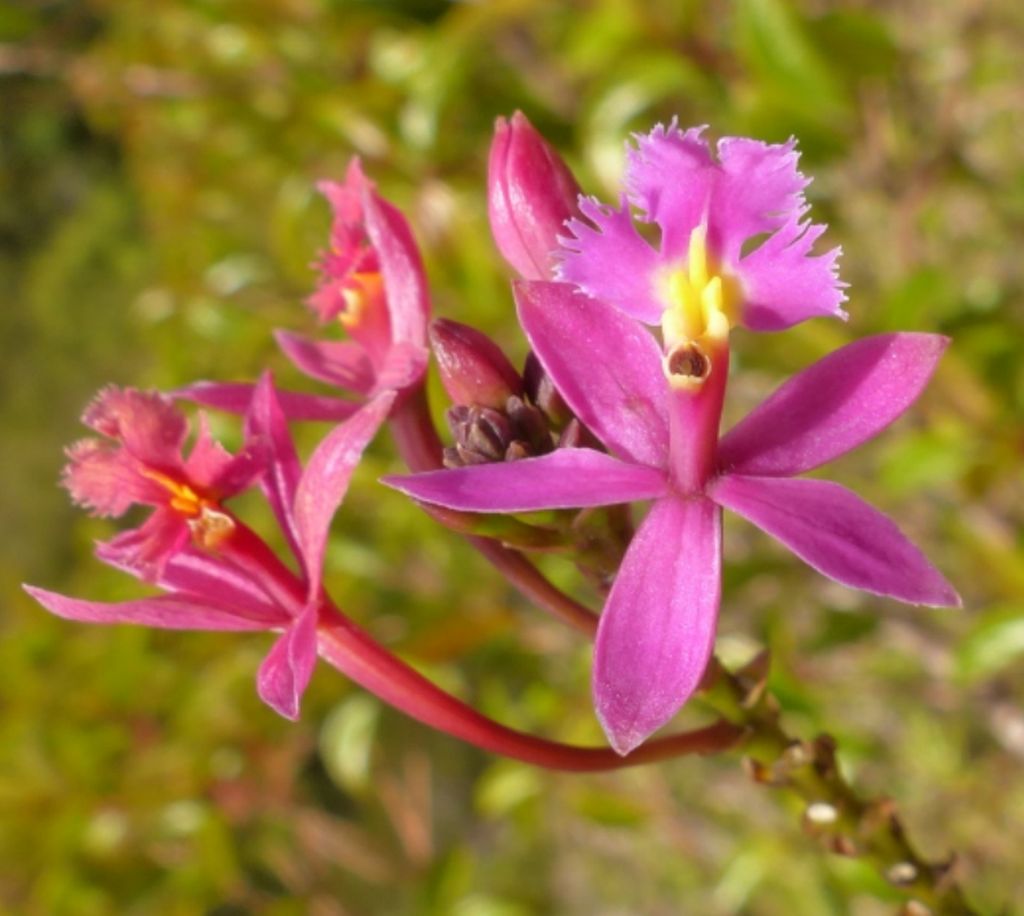

Epidendrum elongatum Jacq. 1789 GROUP Secundum SUBGROUP Elongatum Type for the subgroup
Drawing Photo by L. Charly/Drawing by by © Jimenez, Hágsater & E.Santiago and The AMO Herbario Website



 and
and 
Common Name The Elongated Lip Epidendrum - In Australia The Red Crucifix Orchid
Flower Size 3/4" [3.75 cm]
found found only on Martinique in the Lesser Antilles frequently on citrus trees at elevations of 300 to 700 meters altitude and terrestrial amongst mosses above that, as high as 1250 meters at elevations of meters as a sturdy, erect, medium sized, caespitose, hot to cool growing epiphyte or terrestrial that is a natural hybrid between E cryptopateras and E secundum with an elongate stem carrying alternate, basally clasping, lanceolate leaves that blooms in the spring and summer on a slender, terminal, long stalked, 2' [60 cm] long peduncle covered by remote sheaths bearing a raceme or few branched panicle of a few to many, non-resupinate flowers.
"Epidendrum elongatum Jacq., belongs to the GROUP Secundum which is recognized by the caespitose habit, numerous coriaceous leaves, and generally an elongate peduncle to a pluri-racemose inflorescence, brightly colored flowers generally pollinated by hummingbirds, and the caudicles of the pollinarium granulose, the tetrads appearing like a loose pile of roof-tiles, without any spathaceous bracts; and SUBGROUP Elongatum, recognized by the non-resupinate flowers with a complicated callus. The species has actually been found to be a natural hybrid between Epidendrum secundum Jacq and the new species E cryptopateras as a terrestrial described from around Caracas which has orange flowers, has a much smaller callus than Epidendrum tulcanense which also has orange to tomato red flowers with a white callus, the callus formed by 9 tubercles in two series, the basal two pairs of 2 tubercles each, the main apical body of 5 sub-equal tubercles. Epidendrum cochlidium Lindl. described from a collection by Mathews from Peru is said to have a large, complex callus, with the apex of the callus reaching the apical sinus of the lip; though color was not recorded by the collector, only suggested by Lindley probably on the basis of the dried material which is brown today. Epidendrum laurelense Hágsater & Dodson (2001) has a similar coloring, but a much more open raceme, petals 3-veined, the veins unbranched, and the lobes of the lip narrower; it is found at lower altitude in the basin of Maldonado. Epidendrum imperator Hágsater (2004) from Antioquia has larger flowers, sepals .56 to .72" [14 to 18 mm] long, the mid-lobe of the lip much reduced, and the lateral lobes retrorse, the posterior margin dentate." Adapted from E tulcanense Icones Plate 1491 Hagsater etal 2013
Synonyms Epidendrum calanthum var. rubrum Stehlé 1939;
References W3 Tropicos, Kew Monocot list , IPNI ; Xenia Orchidaceae Vol 3 Reichenbach 1878 drawing; Die Orchideen Schlechter 1915; Repert. Spec. Nov. Regni Veg. Beih. 10: 70 Schlechter 1922; Venezuelan Orchids Illustrated Vol 2 Dunsterville & Garay 1961 as E secundum drawing fide; Encyclopedia of Cultivated Orchids Hawkes 1965; Die Orchideen #9 511 - 579 tafel 9 Rudolph Schlechter 1971 drawing/photo fide; Flora of the Lesser Antilles Garay & Sweet 1974 drawing fide; Orchidaceae Brasilense Band 1 Pabst & Dungs 1975 drawing good; Die Orchideen 3 Auflage Bd 1 Sonderabdruck aus Schlechter Lieferung 9 513 - 576 Brieger, Maatsch and Senghas 1977; AOS Bulletin Vol 49 No 5 1979 photo fide; Orchids of Venezuela, An Illustrated Field Guide Vol 1 Dunsterville & Garay 1979 drawing fide; Venezuelan Orchids Dunsterville 1987 drawing/photo fide; Orchids Travel By Air A Pictoral Safari Mulder, Mulder-Roelfsema and Schuiteman 1990 photo fide; Native Colombian Orchids Vol 4 COS 1994 #858 as E sp photo soso; Native Colombian Orchids Vol 6 COS 1998 errata; Venezuela, Paraiso de Orquideas Romero 1997 photo fide; Orchids of Venezuela [An illustrated field guide] Vol. 1 Ramiro and Carnevali 2000 as E secunda drawing fide; Orquideas Nativas del Tachira Cesar Fernandez 2003 photo ok; Native Australian Orchids Jones 2006 photo fide; Icones Orchidacearum 8 Plate 877 Hagsater 2007 see recognition section; The Organ Mountain Range Its History and its Orchids Miller, Warren, Miller & Seehawer 2008 drawing good; Icones Orchidacearum 14 Plate 1491 Hagsater & Santiago 2013 See recognition section; Orquideas, Tesoro de Colombia Vol 2 Ortiz & Uribe 2017 as E cf elongatum Photo good; Icones Orchidacearum 17(1) Plate 1715 Hagsater & Jimenez 2019 see recognintion section; Icones Orchidacearum 17(1) Plate 1719 Hagsater & Jimenez 2019 drawing/photo fide
--------------------------------------------------------------------------------------------------------------------------